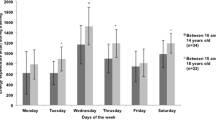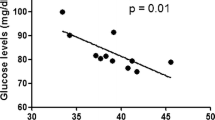Abstract
Background
Variations in body composition and cardiometabolic health biomarkers may affect the physical performance of elite athletes throughout the season.
Aims
To investigate the changes in body composition, cardiometabolic health biomarkers and food consumption throughout the season of male professional soccer players.
Methods
Implementing a longitudinal design, sixteen athletes (25.8 ± 3.1 years, 181.0 ± 6.1 cm, 79.2 ± 6.2 kg) underwent anthropometric and biochemical evaluation in three different moments (T0, T1 and T2) every 16 weeks throughout the season and food consumption was evaluated in the end season.
Results
There was a significant reduction in body fat at the end of the season (T1 vs T2: 11.4 ± 1.5% vs 10.8 ± 1.3%; p = 0.007) and a modest increase in fat-free mass at the same point (T1 vs T2: 48.7 ± 1.4% vs 49.0 ± 1.2%; p = 0.016) with no changes in weight. There was a significant reduction in fasting blood glucose at the end of season (T1 vs T2: 86.6 ± 3.72 mg/dl vs 77.2 ± 4.2 mg/dl; p = 0.000).A reduced hemoglobin concentration was found (T0 vs T2: 15.7 ± 0.8 mg/dl vs 15.0 ± 0.7 mg/dl; p = 0.008), but no changes in hematocrit were observed during the season (p = 0.955). The food consumption of the athletes presented a reduced intake in cereals and pasta (p = 0.000), fruits (p = 0.026) and vegetables (p = 0.000) at the end of the season.
Conclusion
Elite soccer players presented modest improvement or sustained values in body composition and cardiometabolic health biomarkers during the season, despite nutritional inadequacies being observed.


Similar content being viewed by others
References
Thomas DT, Erdman KA, Burke LM (2016) American College os Sports Medicine. Academy of Nutrition and Dietetics Dietitians of Canada. Joint Position Statement. Nutrition and athletic performance. Med Sci Sport Exerc 48(3):543–568. https://doi.org/10.1111/j.1467-3010.1973.tb00679.x
Oliveira C, Ferreira D, Caetano C et al (2017) Nutrition and supplementation in soccer. Sports (Basel) 5(2):1–35. https://doi.org/10.3390/sports5020028
Carling C, Gregson W, McCall A et al (2015) Match running performance during fixture congestion in elite soccer: research issues and future directions. Sport Med 45(5):605–613. https://doi.org/10.1007/s40279-015-0313-z
Nédélec M, McCall A, Carling C et al (2013) Recovery in soccer: part II-recovery strategies. Sport Med 43(1):9–22. https://doi.org/10.1007/s40279-012-0002-0
Bilsborough JC, Greenway K, Livingston S et al (2016) Changes in anthropometry, upper-body strength, and nutrient intake in professional Australian football players during a season. Int J Sports Physiol Perform 11(3):290–300. https://doi.org/10.1123/ijspp.2014-0447
Carling C, Orhant E (2010) Variation in body composition in professional soccer players: interseasonal and intraseasonal changes and the effects of exposure time and player position. J Strength Cond Res 24(5):1332–1339. https://doi.org/10.1519/JSC.0b013e3181cc6154
Malcovati L, Pascutto C, Cazzola M (2003) Hematologic passport for athletes competing in endurance sports: a feasibility study. Sport Hematol 88:570–581
Silva JR, Rebelo A, Marques F et al (2014) Biochemical impact of soccer: an analysis of hormonal, muscle damage, and redox markers during the season. Appl Physiol Nutr Metab 39(4):432–438. https://doi.org/10.1139/apnm-2013-0180
Lee EC, Fragala MS, Kavouras SA et al (2017) Biomarkers in sports and exercise: tracking health, performance, and recovery in athletes. J Strength Cond Res 31(10):2920–2937. https://doi.org/10.1016/j.soncn.2012.03.005
Ndlec M, McCall A, Carling C et al (2012) Recovery in Soccer: part I-post-match fatigue and time course of recovery. Sport Med 42(12):997–1015. https://doi.org/10.2165/11635270-000000000-00000
Faulkner JÁ (1968) Physiology of swimming and diving. In: Falls H (ed) Exercise physiology. Academic Press, Baltimore, pp 415–446
Perini TA, Oliveira GL, Ornellas JS et al (2005) Cálculo do erro técnico de medição em antrpomeetria. Rev Bras Med do Esporte 11(1):81–85. https://doi.org/10.1590/S1517-86922005000100009
Salvo VLM, Gimeno SGA (2002) Reprodutibilidade e validade do questionario de frequência de consumo de alimentos. Rev Saude Publica 36(4):505–512. https://doi.org/10.1590/S0034-89102002000400018
Brasil. Ministério da Saúde (2014) Guia Alimentar Para a População Brasileira/Ministério da Saúde, Secretaria de Atenção à Saúde, Departamento de Atenção Básica.–2.ed.–Brasília: Ministério da saúde. http://bvsms.saude.gov.br/bvs/publicacoes/guia_alimentar_populacao_brasileira_2ed.pdf (accessed on 10 December 2017)
Milanese C, Cavedon V, Corradini G et al (2015) Seasonal DXA-measured body composition changes in professional male soccer players. J Sports Sci 33(12):1219–1228. https://doi.org/10.1080/02640414.2015.1022573
Casajús JÁ (2001) Seasonal variation in fitness variables in professional soccer players. J Sports Med Phys Fitness 41(4):463–469
Fagherazzi S, Dias RL, Bortolon F (2008) Impact of isolated and combined with diet physical exercise on the Hdl, Ldl, total cholesterol and triglycerides plasma levels. Rev Bras Med Esporte. https://doi.org/10.1590/s1517-86922008000400012
Lobo V, Patil A, Phatak A et al (2010) Free radicals, antioxidants and functional foods: impact on human health. Pharmacognol Ver 4(8):118–126. https://doi.org/10.4103/0973-7847.70902
Meyer T, Meister S (2011) Routine blood parameters in elite soccer players. Int J Sport Med 32(11):875–881. https://doi.org/10.1055/s-0031-1280776
Swaminathan R, Major P, Snieder H et al (2000) Serum creatinine and fat-free mass (lean body mass). Clin Chem 46(10):1695–1696
Banfi G (2006) Relation between serum creatinine and body mass index in elite athletes of different sport disciplines. Br J Sports Med 40(8):675–678. https://doi.org/10.1136/bjsm.2006.026658
Shaskey DJ, Green GA (2000) Sports haematology. Sport Med 29(1):27–38
Koperdanova M, Cullis JO (2015) Interpreting raised serum ferritin levels. BMJ 351:h3692. https://doi.org/10.1136/bmj.h3692
García PMR, García-Zapico P, Patterson ÁM et al (2014) Nutrient intake and food habits of soccer players: analyzing the correlates of eating practice. Nutrients 6(7):2697–2717. https://doi.org/10.3390/nu6072697
Raizel R, da Mata Godois A, Coqueiro AY et al (2017) Pre-season dietary intake of professional soccer players. Nutr Health 23(4):215–222. https://doi.org/10.1177/0260106017737014
Stolen T, Chanari K, Castagna C et al (2005) Physiology of soccer: an update. Sport Med 35(6):501–536
Kerksick CM, Wilborn CD, Roberts MD et al (2018) ISSN exercise & sports nutrition review update: research & recommendations. J Int Soc Sports Nutr 15(1):38. https://doi.org/10.1186/s12970-018-0242-y
Author information
Authors and Affiliations
Corresponding author
Ethics declarations
Conflict of interest
The authors declare no conflicts of interest.
Ethical approval
The study protocol was approved by the Research Ethics Committee of the Methodist University Center IPA, under protocol number 137/2006, according to Resolution 196/96 of the Ministry of Health. The study was conducted in accordance with the requirements of the declarations of Helsinki.
Informed consent
All participants were informed about the procedures and signed an informed consent form prior to enrollment in the study.
Additional information
Publisher's Note
Springer Nature remains neutral with regard to jurisdictional claims in published maps and institutional affiliations.
Rights and permissions
About this article
Cite this article
Matos, V.A.F., de Carvalho, C.S. & Fayh, A.P.T. Seasonal changes in body composition and cardiometabolic health biomarkers in professional soccer players: a longitudinal study. Sport Sci Health 16, 419–424 (2020). https://doi.org/10.1007/s11332-019-00617-2
Received:
Accepted:
Published:
Issue Date:
DOI: https://doi.org/10.1007/s11332-019-00617-2




